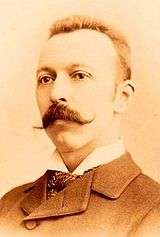Léon Boëllmann

Léon Boëllmann (September 25, 1862 – October 11, 1897) was a French composer of Alsatian origin, known for a small number of compositions for organ. His best-known composition is Suite gothique (1895), still very much a staple of the organ repertoire, especially its dramatic concluding Toccata.
Biography
Boëllmann was born in Ensisheim, Haut-Rhin, the son of a pharmacist. In 1871, at the age of nine, he entered the École de Musique Classique et Religieuse (L'École Niedermeyer) in Paris, where he studied with its director, Gustave Lefèvre, and with Eugène Gigout. Boëllmann there won first prizes in piano, organ, counterpoint, fugue, plainsong, and composition.[1] After his graduation in 1881, Boëllmann was hired as "'organiste de choeur'" at the Church of St. Vincent de Paul[2] in the 10th arrondissement of Paris, and six years later he became cantor and "organiste titulaire," a position he held until his early death, probably from tuberculosis.
In 1885, Boëllmann married Louise, the daughter of Gustave Lefèvre and the niece of Eugène Gigout, into whose house the couple moved. (Having no children of his own, Gigout adopted Boëllmann.) Boëllmann then taught in Gigout's school of organ playing and improvisation.
As a favored student of Gigout, Boëllmann moved in the best circles of the French musical world, and as a pleasing personality, he made friends of many artists and was able to give concerts both in Paris and the provinces.[3] Boëllmann became known as "a dedicated teacher, trenchant critic, gifted composer and successful performer...who coaxed pleasing sounds out of recalcitrant instruments." Boëllmann also wrote musical criticism for L'art musical under the pseudonym "le Révérend Père Léon" and "un Garçon de la salle Pleyel."[4]
Boëllmann died in 1897, aged only 35. After the death of his wife the following year, Gigout reared their three orphans, one of whom, Marie-Louise Boëllmann-Gigout (1891–1977), became a noted organ teacher in her own right.[5]
Works
During the sixteen years of his professional life, Boëllmann composed about 160 pieces in all genres. Faithful to the style of Franck and an admirer of Saint-Saëns, Boëllmann yet exhibits a turn-of-the-century Post-romantic esthetic, which especially in his organ works, demonstrates "remarkable sonorities."[3] His best-known composition is Suite gothique (1895), now a staple of the organ repertoire, especially its concluding Toccata, a piece "of moderate difficulty but brilliant effect," with a dramatic minor theme and a rhythmic emphasis that made it popular even in Boëllmann's own day.[6] Boëllmann also wrote motets and art songs, works for piano, a symphony,[7] works for cello and orchestra and for organ and orchestra, a cello sonata (dedicated to Jules Delsart), and other chamber works.[8]
List of compositions

Organ
- Douze pièces, Op. 16 (1890)
- Suite gothique, Op. 25 (1895)
- Deuxième suite, Op. 27 (1896)
- Les heures mystiques, Opp. 29/30 (1896)
- Ronde française, Op. 37 (arr. Choisnel)
- Offertoire sur les Noëls
- Fantaisie
Piano
- Valse Op. 8
- Deuxième Valse, Op. 14
- Aubade, Op 15:1
- Feuillet d'Album, Op 15:3
- 2e Impromptu, Op 15:4
- Improvisations, Op. 28
- Nocturne, Op. 36
- Ronde française, Op. 37
- Gavotte
- Prélude & fugue
- Scherzo-Caproce
Chamber
- Piano Quartet in F minor, Op. 10
- Piano Trio in G major, Op. 19
- Sonata for Cello and Piano in A minor, Op. 40
Voice
- Conte d'amour, Op. 26 (3 melodies)
Orchestra
- Fantaisie dialoguée, Op. 35 for organ and orchestra
- Intermezzo, for orchestra
- Ma bien aimée, for voice and orchestra
- Rondel, for small orchestra
- Scènes du Moyen-Âge, for orchestra
- Symphonie in F, Op. 24
- Variations symphoniques, Op. 23, for cello and orchestra
Recordings Selection
- Suite gothique, op. 25, Deuxième Suite, op. 27, Offertoire sur des noëls, Carillon et Choral des Douze Pièces op. 16, Deux esquisses, Fantaisie, Heures mystiques (extraits), op. 29 & 30, Helga Schauerte-Maubouet, Kuhn organ of Minden cathedral (Germany), Syrius SYR 141374.
References
- ↑ Felix Aprahamian, "Boëllmann, Léon," New Grove Dictionary of Music and Musicians, 2: 841.
- ↑ The organ was built by one of the most noted makers of the nineteenth century, Aristide Cavaillé-Coll.
- 1 2 Havard de la Montagne.
- ↑ Aprahamian.
- ↑ Denis Havard de la Montagne, "Léon Boëllmann," Musimem.com; Aprahamian.
- ↑ Aprahamian; Havard de la Montagne.
- ↑ Publisher's Catalog, including Boëllmann Symphony (PDF). Paris: Durand-Salabert-Eschig. p. 38. Retrieved 2008-08-24.
- ↑ Aprahamian; "Incomplete List of Boëllmann's Works". IMSLP. Retrieved 2008-08-24.
External links
- "Brief biography and summary of Boëllmann's organ music with recommended recordings". Naxos Records. Retrieved 2008-08-24.
- Peetz, Juliane (2004). "Concise biography of Boëllmann (Program Notes for a Recital Containing the Suite gothique)" (in German). Retrieved 2008-08-24.
- Concise biography of Boëllmann (same as link above but translated with Google into English)
- Detailed biography with some images (French)
- Detailed biography with some images (same link as above, but translated with Google into English)
- Free scores by Léon Boëllmann at the International Music Score Library Project
- Leon Boëllmann Piano Quartet, Op.10 & Piano Trio, Op.19 Sound-bites
- Verset de procession, for organ (From the Sibley Music Library Digital Score Collection)